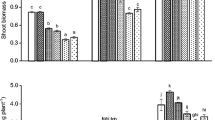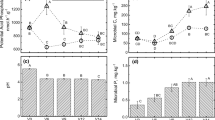Abstract
Legumes have been shown to improve the phosphorus (P) uptake and growth of subsequent cereals even when all legume residues (including roots) are removed, but the mechanism(s) responsible have not been elucidated. Further, this phenomenon has not been investigated in high P-fixing soils, which are prevalent in tropical and subtropical regions where P deficiency in soils is a major global issue. We tested the hypothesis that carbon (C) inputs into the soil from the roots of legumes may increase labile organic C pools and microbial biomass in soil cf. wheat (Triticum aestivum L.), with consequences for subsequent wheat growth. The hypothesis was tested by cultivating wheat after pre-cropping of the soil with either wheat, faba bean (Vicia faba L.), chickpea (Cicer arietinum L.) or an unplanted fallow in a high-P-fixing Ferralsol, with or without P fertiliser addition to the pre-crop, under glasshouse conditions. The addition of P fertiliser resulted in significantly higher P concentrations in the NaHCO3-Pi, NaOH-Pi and HCl-Po pools in the bulk soil after the pre-crop phase, but resulted in significantly lower water-Po, NaHCO3-Po, NaOH-Po and total organic C (TOC) concentrations. Neither of the legumes nor wheat changed the soil P pools, with the exception of the water-Pi pool, which was significantly higher following chickpea where P fertiliser was applied. While the faba bean pre-crops resulted in higher total microbial biomass under nil-P fertiliser conditions, these changes did not result in enhanced growth of the subsequent wheat crop. Notably, a strong negative correlation between subsequent wheat growth and the amount of P removed by the pre-crop was observed both with (r = −0.60) and without (r = −0.80) P fertiliser, suggesting that in high P-fixing soils the depletion of P pools by pre-crops limits the growth of subsequent cereals. Any benefits of legumes to P cycling in rotations on high P-fixing soils likely relies on contributions from the mineralisation of root residues (and shoot residues where these are retained) to soil P availability, rather than any rhizosphere-specific changes in soil P pools induced by legumes.


Similar content being viewed by others
References
Andrews M, Sprent JI, Raven JA, Eady PE (1999) Relationships between shoot to root ratio, growth and leaf soluble protein concentration of Pisum sativum, Phaseolus vulgaris and Triticum aestivum under different nutrient deficiencies. Plant Cell Environ 22:949–958
Anstoetz M, Rose TJ, Clark MW, Yee LH, Raymond CA, Tony Vancov T (2015) Novel applications for Oxalate-Phosphate-Amine Metal-Organic-Frameworks (OPA-MOFs): can an iron-based OPA-MOF be used as slow-release fertilizer? PLoS One. doi:10.1371/journal.pone.0144169
Batjes NH (1997) A world data set of derived soil properties by FAOUNESCO soil unit for global modeling. Soil Use Manag 13:9–16
Batjes NH (2011) Global distribution of soil phosphorus retention potential. ISRIC–World Soil Information, Wageningen, ISRIC Report 2011/06
Bovill WD, Huang CY, McDonald GK (2013) Genetic approaches to enhancing phosphorus-use efficiency (PUE) in crops: challenges and directions. Crop Pasture Sci 64:179–198
Craine JM, Morrow C, Fierer N (2007) Microbial nitrogen limitation increases decomposition. Ecology 88:2105–2113
Damon PM, Bowden B, Rose T, Rengel Z (2014) Crop residue contributions to phosphorus pools in agricultural soils: a review. Soil Biol Biochem 74:127–137
Elias NV, Herridge DF (2014) Crop-available water and agronomic management, rather than nitrogen supply, primarily determine grain yield of commercial chickpea in northern New South Wales. Crop Pasture Sci 65:442–452
FAO–UNESCO (1974) Soil map of the world. Food and Agriculture Organization of the United Nations, Rome
Foyjunnessa MNA, Doolette A, Mason S, McLaughlin MJ (2014) In situ 33P-labelling of canola and lupin to estimate total phosphorus accumulation in the root system. Plant Soil 382:291–299
Guo F, Yost RS, Hue NV, Evensen CI, Silva JA (2000) Changes in phosphorus fractions in soils under intensive plant growth. Soil Sci Soc Am J 64:1681–1689
Guppy CN, Menzies NW, Moody PW, Compton BL, Blamey FPC (2000) A simplified sequential sampling phosphorus fractionation method. Commun Soil Sci Plant Anal 31:1981–1991
Guppy CN, Menzies NW, Moody PW, Blamey FPC (2005) Competitive sorption reactions between phosphorus and organic matter in soil: a review. Aust J Soil Res 43:189–202
Hartman WH, Richardson CJ (2013) Differential nutrient limitation of soil microbial biomass and metabolic quotients (qCO2): is there a biological stoichiometry of soil microbes? PLoS One 8:e57127. doi:10.1371/journal.pone.0057127
Hedley MJ, Stewart JWB, Chauhan BS (1982) Changes in inorganic and organic soil P fraction induced by cultivation practices and by laboratory incubation. Soil Sci Soc Am J 46:970–976
Herridge DF, Peoples MB, Boddey RM (2008) Global inputs of biological nitrogen fixation in agricultural systems. Plant Soil 311:1–18
Hinsinger P, Betencourt E, Bernard L, Brauman A, Plassard C, Shen J, Tang X, Zhang FS (2011) P for two, sharing a scarce resource: soil phosphorus acquisition in the rhizosphere of intercropped species. Plant Physiol 156:1078–1086
Jones DL, Dennis PG, Owen AG, van Hees PAW (2003) Organic acid behavior in soils—misconceptions and knowledge gaps. Plant Soil 248:31–41
Kamh M, Horst WJ, Am F, Mostafa H, Maier P (1999) Mobilisation of soil and fertiliser phosphate by cover crops. Plant Soil 211:19–27
Kamh M, Abdou M, Chude V, Wiesler F, Horst WJ (2002) Mobilization of phosphorus contributes to positive rotational effects of leguminous cover crops on maize grown on soils from Northern Nigeria. J Plant Nutr Soil Sci 572:566–572
Liebich F, Keller F, Huguenin-Elie O, Frossard E, Oberson A, Bünemann EK (2014) Seasonal dynamics and turnover of microbial phosphorus in a permanent grassland. Biol Fertil Soils 50:465–476
MacDonald GK, Bennet EM, Potter PA, Ramankutty N (2011) Agronomic phosphorus imbalance across the world’s croplands. PNAS 108:3086–3091
Malik RS, Seymour M, French RJ, Kirkegaard JA, Lawes RA, Liebig MA (2015) Dynamic crop sequencing in Western Australian cropping systems. Crop Pasture Sci 66:594–609
Maltais-Landry G (2015) Legumes have a greater effect on rhizosphere properties (pH, organic acids and enzyme activity) but a smaller impact on soil P compared to other cover crops. Plant Soil 394:139–154
Mat Hassan H, Marschner P, Mcneill A, Tang C (2012a) Growth, P uptake in grain legumes and changes in rhizosphere soil P pools. Biol Fertil Soils 48:151–159
Mat Hassan H, Marschner P, Mcneill A, Tang C (2012b) Grain legume pre-crops and their residues affect the growth, P uptake and size of P pools in the rhizosphere of the following wheat. Biol Fertil Soils 48:775–785
McBeath TM, Gupta VVSR, Llewellyn RS, Davoren CW, Whitbread AM (2015) Break-crop effects on wheat production across soils and seasons in a semi-arid environment. Crop Pasture Sci 66:523–552
Nuruzzaman M, Lambers H, Bolland MDA, Veneklaas EJ (2005) Phosphorus uptake by grain legumes and subsequently grown wheat at different levels of residual phosphorus fertiliser. Aust J Agric Res 56:1041–1047
Pearse SJ, Veneklaas EJ, Cawthray GR, Bolland MDA, Lambers H (2006) Carboxylate release of wheat, canola and 11 grain legumes as affected by phosphorus status. Plant Soil 288:127–139
Rayment GE, Lyons DJ (2011) Soil chemical methods—Australasia. CSIRO Publishing, Australia
Richardson AE, Hocking PJ, Simpson RJ, George TS (2009) Plant mechanisms to optimise access to soil phosphorus. Crop Pasture Sci 60:124–143
Rose TJ, Wissuwa M (2012) Rethinking internal phosphorus utilization efficiency (PUE): a new approach is needed to improve PUE in grain crops. Adv Agron 80:183–215
Rose TJ, Rengel Z, Bowden J, Ma Q (2007) Differential accumulation of phosphorus and potassium by canola cultivars compared to wheat. J Soil Sci Plant Nutr 170:404–411
Rose TJ, Damon P, Rengel Z (2010a) Phosphorus-efficient faba bean (Vicia faba L.) genotypes enhance subsequent wheat crop growth in an acid and an alkaline soil. Crop Pasture Sci 61:1009–1016
Rose TJ, Hardiputra B, Rengel Z (2010b) Wheat, canola and grain legume access to soil phosphorus fractions differs in soils with contrasting phosphorus dynamics. Plant Soil 326:159–170
Rose TJ, Julia CC, Shepherd M, Rose MT, Van Zwieten, L (2016) Faba bean is less susceptible to fertiliser N impacts on biological N2 fixation than chickpea in monoculture and intercropping systems. Biol Fertil Soils 52(2):271–276. http://doi.org/10.1007/s00374-015-1062-8
Scanlan C, Brennan R, Sarre GA (2015) Effect of soil pH and crop sequence on the response of wheat (Triticum aestivum) to phosphorus fertiliser. Crop Pasture Sci 66:23-31
Simpson RJ, Oberson A, Culvenor RA, Ryan MH, Veneklaas EJ, Lambers H, Lynch JP, Ryan PR, Delhaize E, Smith FA, Smith SE, Harvey PR, Richardson AE (2011) Strategies and agronomic interventions to improve the phosphorus-use efficiency of farming systems. Plant Soil 349:89–120
Slavich PG, Sinclair K, Morris SH, Kimber SWL, Downie A, Van Zwieten L (2013) Contrasting effects of manure and green waste biochars on the properties of an acidic ferralsol and productivity of a subtropical pasture. Plant Soil 366:213–227
Sugihara S, Tomita Y, Nishigaki T, Kilasara M, Wasaki J, Funakawa S (2016) Effects of different phosphorus-efficient legumes and soil texture on fractionated rhizosphere soil phosphorus of strongly weathered soils. Biol Fertil Soils 52:367–376
Van Zwieten L, Rose TJ, Herridge D, Kimber S, Rust J, Cowie A, Morris S (2015) Enhanced biological N2 fixation and yield of faba bean (Vicia faba L.) in an acid soil following biochar addition: dissection of causal mechanisms. Plant Soil 395:7–20
Vance ED, Brookes PC, Jenkinson DS (1987) An extraction method for measuring soil microbial biomass C. Soil Biol Biochem 19:703–707
VSN International (2014) GenStat for Windows 16th edition. VSN International, Hemel Hempstead
Author information
Authors and Affiliations
Corresponding author
Rights and permissions
About this article
Cite this article
Rose, T.J., Wood, R.H., Gleeson, D.B. et al. Removal of phosphorus in residues of legume or cereal plants determines growth of subsequently planted wheat in a high phosphorus fixing soil. Biol Fertil Soils 52, 1085–1092 (2016). https://doi.org/10.1007/s00374-016-1143-3
Received:
Revised:
Accepted:
Published:
Issue Date:
DOI: https://doi.org/10.1007/s00374-016-1143-3




